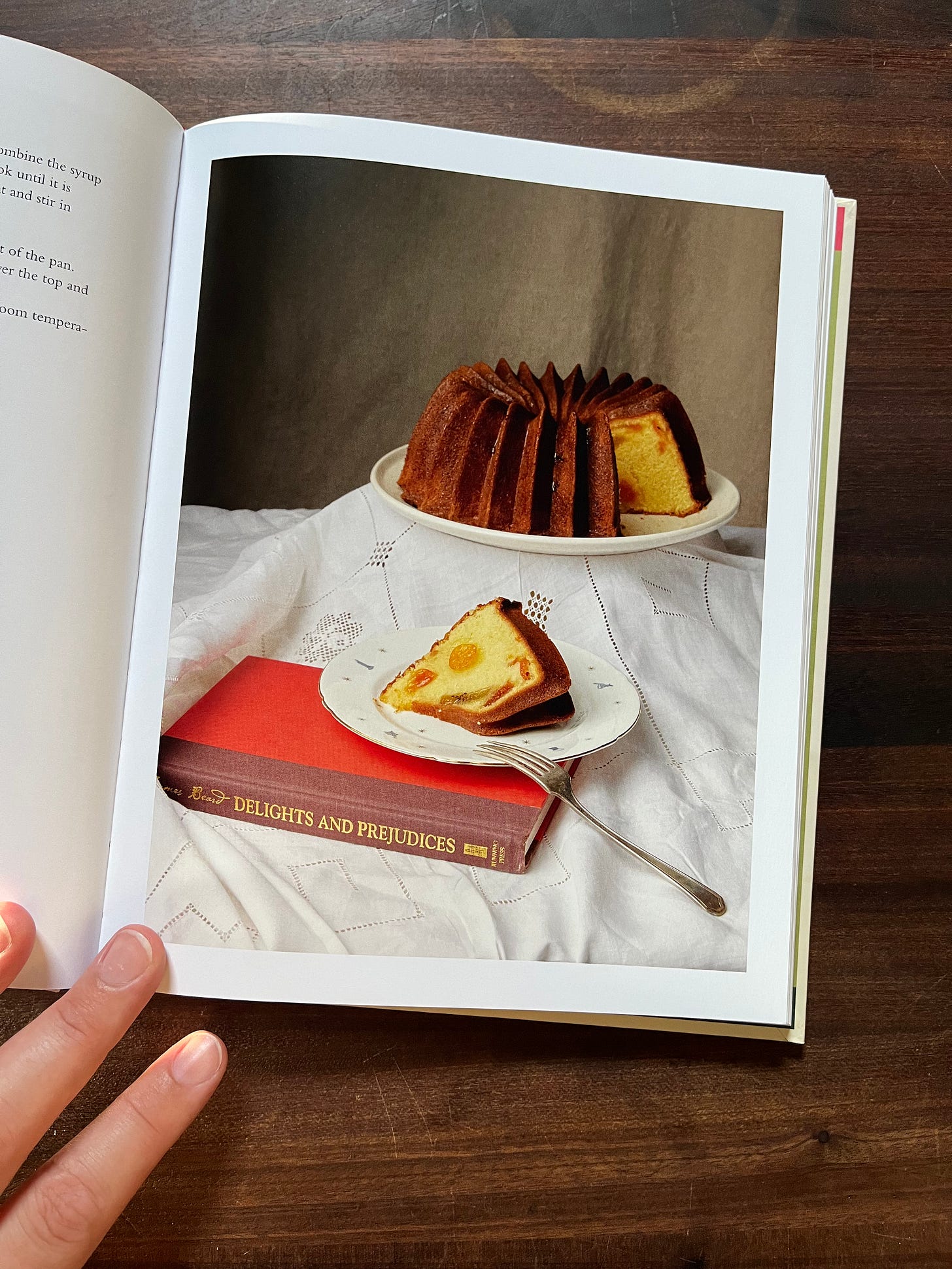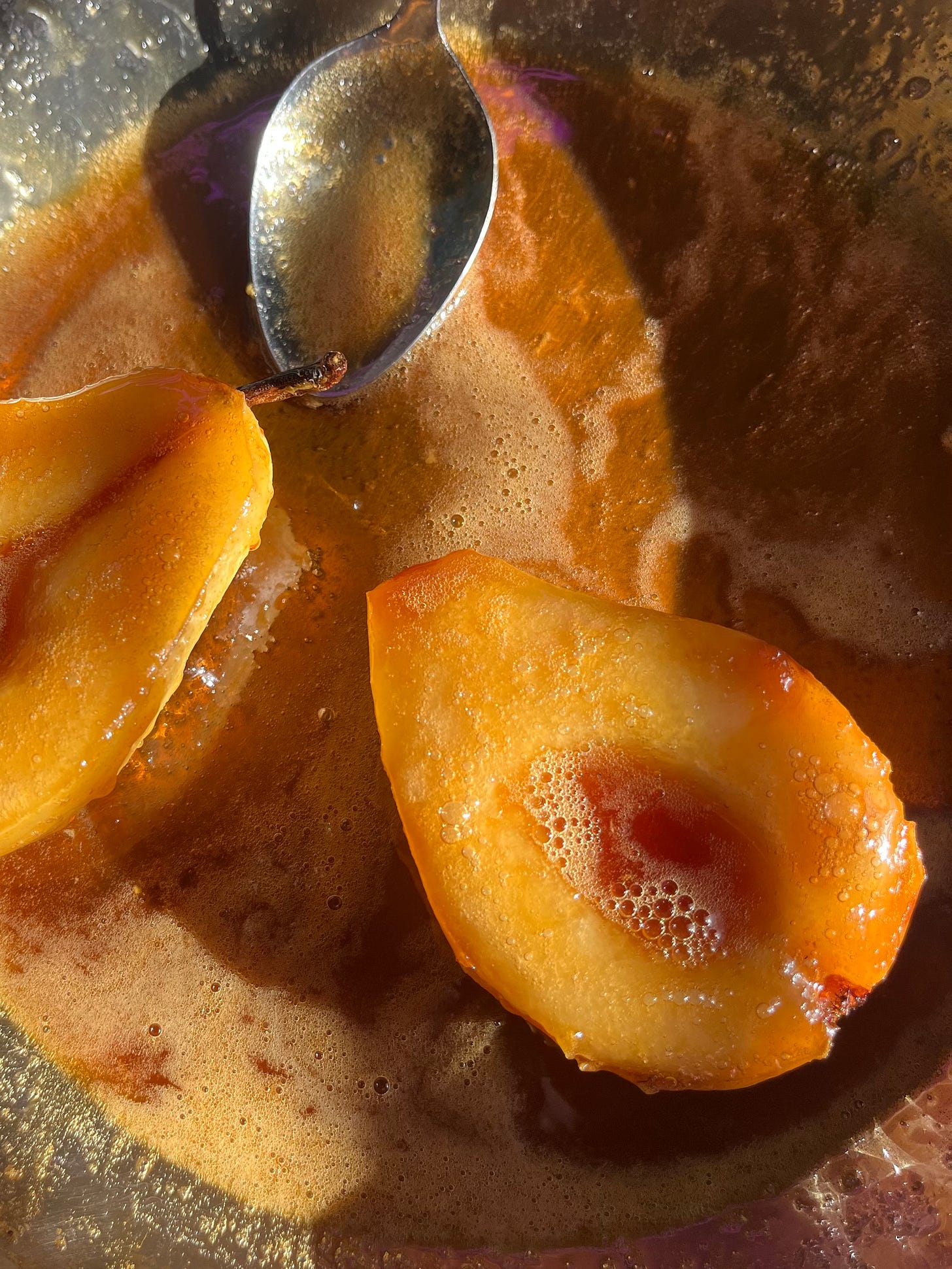Honeyed Pears with Meadowsweet Custard
A Redwall-inspired dessert
Before I dive in -
I want to shout out my friend Camilla Wynne’s incredible new book, Nature’s Candy : Timeless and Inventive Recipes for Creating and Baking with Candied Fruit. If you’re on social media in the baking sphere you have probably already seen many folks wax poetic about this book, so let me just say that Camilla’s work has transformed my relationship to using local fruit. I used to get a sort of panicky feeling when a new fruit varietal appeared for its brief Louisiana season at the market. If I didn’t buy scads of it, then I was missing out. Camilla’s careful and joyful instruction in candying and preserving fruit has allowed me to let my guard down. I buy what I want (and what I can afford), and use her recipes to preserve it for another day. The technique of candying fruit isn’t difficult, but it does require that we give ourselves time to slow down and engage thoughtfully in a process, a practice that I think we could all really use right now.
Plus, the photos (styled by Michelle Marek and photographed by Mickaël A. Bandassak) are totally gorgeous:
For what it’s worth, I was sent a promotional copy of the book but I had pre-ordered it anyway. If you are desperate for the book but can’t afford it, shoot me a dm on Instagram and I’ll send you my extra copy.
On honeyed pears
I’ve had a note pinned to my bulletin board1 for nearly a month now. It says: “Cheesecake, by 10/27”. It’s a reminder to develop a recipe I’ve been kicking around in my head for a while now- a caramel pear cheesecake, for this very newsletter. I’ve bought the pears to test it twice. Each time, I’ve positioned them carefully in a trifle bowl, nestled in a dinner napkin, so they can take their time to ripen without being bruised. This is the only way I’ve found to have a good pear in this part of the country. We have no farmer’s market pears here, and the only ones you can buy arrive at the grocery store rock-hard. I have waited over two weeks for a supermarket pear to approach acceptability. Each time, I end up cutting them up into my father-in-law’s morning oatmeal. I simply haven’t had the juice for an unpaid, complex, recipe development project.
My wife and I have a shorthand for the constant, droning misery of the world buzzing in the corner of our vision: the horrors. How am I? Fine, except for, of course, the horrors. It’s a handy stand-in for Palestine, the election, climate change, or the fact that we are living with a person who is dying. I know I’m not alone in feeling like, lately, the horrors have profoundly fractured my creative attention. I find myself longing to lose myself in a creative project. More often than not, I lose myself by playing Tetris on the family Nintendo Switch.
Which is why, last week, it felt like a gift when I was suddenly consumed by a kitchen experiment. The inspiration came from an unexpected place: my worn hardcover copy of Mattimeo, part of the Redwall series of children’s books by the British author Brian Jacques. Perhaps not so unexpected, though - Jacques is rightly famous for his electrifying depictions of banquets, filled with detailed, stirring descriptions of food, all lovingly prepared by anthropomorphic mice, squirrels, moles, badgers, and otters. I was totally obsessed with the books as a kid. They are mostly tales of grand adventure, friendship, and bravery, but the feasts always captivated me too. I was asked by Cake Zine recently if there was a fictional depiction of food that lives rent-free in my head, and my immediate answer was my beloved Redwall. Here is a scene from Mattimeo, where a brash young mouse, the son of a famous father, attends a banquet:
“Then there were the cakes, tarts, jellies, and sweets. Raspberry muffins, blueberry scones, redcurrant jelly, Abbot’s cake, fruitcake, iced cake, shortbread biscuits, almond wafers, fresh cream, honeyed cream, custardy cream, Mrs. Churchmouse’s bell tower pudding, Mrs. Bankvole’s six-layer trifle, Cornflower’s gatehouse gateau, Sister Rose’s sweetmeadow custard with honeyglazed pears, Brother Rufus’s wildgrape woodland pie with quince and hazelnut sauce...”
Reading this, I remembered my overlooked pears, still in their nest. I googled sweetmeadow, which isn’t really a thing, but meadowsweet absolutely is: an herb often steeped as a tisane, and occasionally used in herbal medicine practices. From Wikipedia:
“Filipendula ulmaria, commonly known as meadowsweet or mead wort, is a perennial herbaceous plant in the family Rosaceae that grows in damp meadows. It is native throughout most of Europe and Western Asia (Near East and Middle East). It has been introduced and naturalised in North America. Meadowsweet has also been referred to as queen of the meadow, pride of the meadow, meadow-wort, meadow queen, lady of the meadow, dollof, meadsweet, and bridewort.”
I’m not a devotee of herbal medicine but I was intrigued by meadowsweet flower’s flavor profile: honey, hay, and bitter almond. I briefly considered ordering some online, but I couldn’t wait - I needed to follow this thread before I lost it. I called our local herb shop, Maypop, and as luck would have it, they had meadowsweet in stock. An hour later I was steeping the mixture, a mix of dried blossoms and leaves, into a créme anglaise.
The honeyglazed pears came easily, thank god. First, I sliced a just-ripe pear in two and used a teaspoon to remove the seedy core. I then covered the bottom of a stainless steel sauté pan with a thin layer of honey (nothing fancy as I would be heating it - I got my honey from Costco). I set the pan over medium heat until the honey started bubbling around the border. When it just began to emit a bare whiff of caramel steam, I nestled the pear halves, cut side down, in the sizzling honey. As the pear halves began to sweat, I spooned the resulting honey-pear poaching liquid over their backs. After about three or four minutes, I had two meltingly tender glazed pear halves.
I wasn’t totally bullish on the flavor of the créme anglaise. I think it may have fared better if I had access to just meadowsweet flowers, as it seems the leaves impart an astringent flavor. I generously salted the creme anglaise to draw out the bitterness and whisked in a dollop of vanilla bean paste. At its best I think it would taste like a sweet-smelling barn, wheaty and earthy. Next time I’ll try it with just hay, perhaps, or steep almonds directly in the custard like I was making orgeat. The pears were sweet and slightly smoky from the caramelization, and I wanted to drink the pool of sticky syrup as it seeped into the custard when I sliced into the fruit.
With thanks to Sister Rose and Brian Jacques, sweetmeadow custard with honeyglazed pears, a dish from a better world than ours:
If you’d like to recreate the recipe, I’d aim to source just the meadowsweet flowers, and use whatever créme anglaise recipe you like -they are mostly all the same. Whatever you use, steep the flowers only briefly. I used about a tablespoon to a cup and a half of liquid. A brief Google search informs me that you shouldn’t use meadowsweet if you are pregnant, but I’m not an expert.
And yes - I’m aware of the Redwall cookbook, I even own a copy! But somehow I’ve never wanted to look too closely, in case the food within doesn’t match what I’ve imagined in my mind.
I don’t actually have a bulletin board - I just tape scraps of paper to the window I face sitting at my desk. It makes me look insane.







Bronwen, thanks for this! As a huge fan of the Wind in the Willows, I’m not sure how I missed out on Redwall. I’m going to have to check it out! Your description of the honey and pears cooking made my mouth water. I’m having a lot of the same feelings you describe. Wishing you strength and peace to face these challenging days.
You had me at "anthropomorphic mice, squirrels, moles, badgers, and otters". This was such a delightful read, full of your voice and lightness, a welcome change to the heaviness of the horrors. Thank you.